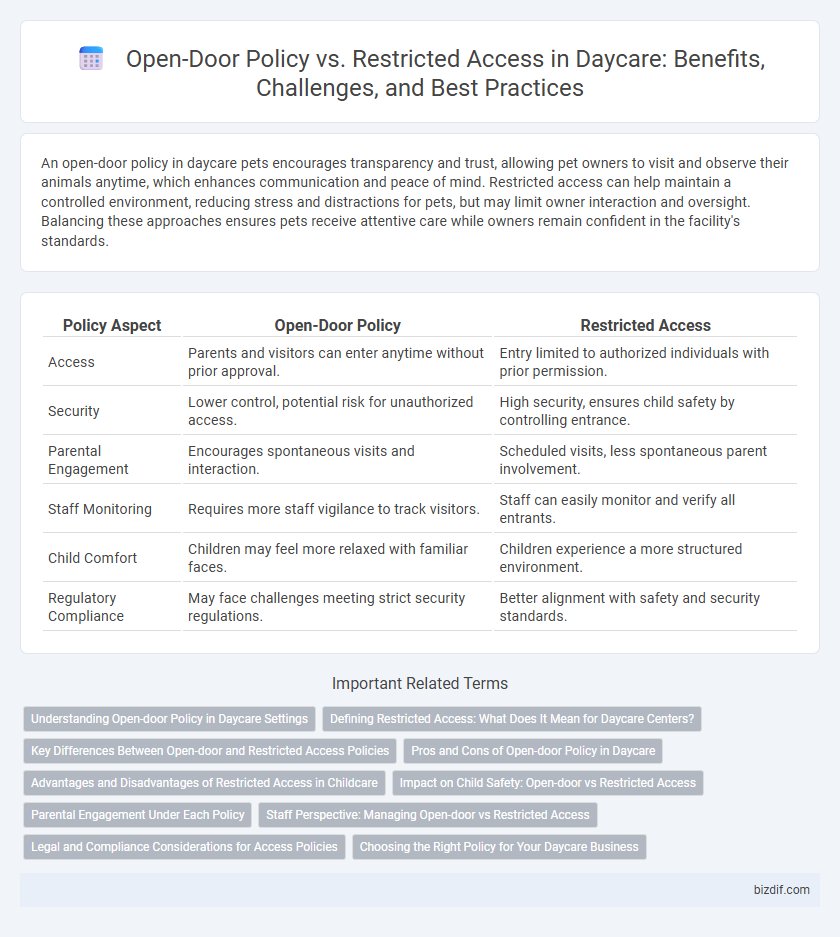An open-door policy in daycare pets encourages transparency and trust, allowing pet owners to visit and observe their animals anytime, which enhances communication and peace of mind. Restricted access can help maintain a controlled environment, reducing stress and distractions for pets, but may limit owner interaction and oversight. Balancing these approaches ensures pets receive attentive care while owners remain confident in the facility's standards.
Table of Comparison
| Policy Aspect | Open-Door Policy | Restricted Access |
|---|---|---|
| Access | Parents and visitors can enter anytime without prior approval. | Entry limited to authorized individuals with prior permission. |
| Security | Lower control, potential risk for unauthorized access. | High security, ensures child safety by controlling entrance. |
| Parental Engagement | Encourages spontaneous visits and interaction. | Scheduled visits, less spontaneous parent involvement. |
| Staff Monitoring | Requires more staff vigilance to track visitors. | Staff can easily monitor and verify all entrants. |
| Child Comfort | Children may feel more relaxed with familiar faces. | Children experience a more structured environment. |
| Regulatory Compliance | May face challenges meeting strict security regulations. | Better alignment with safety and security standards. |
Understanding Open-door Policy in Daycare Settings
An open-door policy in daycare settings allows parents and guardians to visit their children at any time without prior notice, promoting transparency and trust between caregivers and families. This approach fosters stronger communication and reassures parents about their child's safety and well-being. By contrast, restricted access limits visitation to scheduled times, which can reduce spontaneous interaction and potentially hinder parental involvement.
Defining Restricted Access: What Does It Mean for Daycare Centers?
Restricted access in daycare centers means limiting entry to authorized individuals only, enhancing child safety by preventing unsupervised visits. This policy requires stringent identification checks and controlled access points, ensuring that only parents, guardians, and approved caregivers can enter. Implementing restricted access helps daycare centers maintain a secure environment while complying with regulatory standards for child protection.
Key Differences Between Open-door and Restricted Access Policies
Open-door policies in daycare centers emphasize unrestricted parental and visitor access, promoting transparency and fostering trust between caregivers and families. Restricted access policies prioritize child safety by limiting entry to authorized individuals, often requiring sign-in procedures and secure entry systems. Key differences include the level of supervision, ease of parental involvement, and the balance between accessibility and security measures.
Pros and Cons of Open-door Policy in Daycare
Open-door policies in daycare centers promote transparency, allowing parents to visit anytime, which builds trust and strengthens parent-provider relationships. This approach can enhance child monitoring and immediate communication but may cause disruptions to daily routines or create security concerns. Balancing open access with structured schedules is essential to maintain a safe and focused learning environment.
Advantages and Disadvantages of Restricted Access in Childcare
Restricted access in childcare enhances security by limiting entry to authorized individuals, reducing the risk of unauthorized pickups and ensuring children's safety. However, this policy can create inconvenience for parents who need to adhere to strict visiting hours or verification processes, potentially reducing flexibility in emergency situations. Balancing restriction with accessibility is crucial to maintain a secure yet welcoming environment for families.
Impact on Child Safety: Open-door vs Restricted Access
An open-door policy in daycare settings promotes transparency and trust among parents but may increase the risk of unauthorized individuals entering the premises. Restricted access systems, utilizing secure entry points and staff-only areas, significantly enhance child safety by controlling who can enter and exit the facility. Prioritizing restricted access reduces potential threats while maintaining a safe and secure environment for children to learn and play.
Parental Engagement Under Each Policy
Open-door policies in daycare centers promote higher parental engagement by allowing parents frequent, unscheduled visits, fostering transparency and trust. Restricted access policies may limit spontaneous interactions but can create structured communication opportunities through scheduled meetings and updates. Both approaches impact the quality and frequency of parent-staff collaboration and influence parental confidence in childcare routines.
Staff Perspective: Managing Open-door vs Restricted Access
Staff managing an open-door policy in daycare settings prioritize transparency and trust, allowing parents continual access to observe and engage with their children, which fosters stronger relationships and reassurance. In contrast, restricted access requires staff to implement controlled entry protocols to ensure child safety and minimize disruptions, demanding rigorous monitoring and clear communication with parents about visitation guidelines. Balancing open-door transparency with the security benefits of restricted access relies on staff's ability to adapt policies that support child welfare, operational efficiency, and parental involvement.
Legal and Compliance Considerations for Access Policies
Daycare centers must balance open-door policies with stringent restricted access controls to ensure legal compliance with child safety regulations and privacy laws such as the Children's Online Privacy Protection Act (COPPA) and the Family Educational Rights and Privacy Act (FERPA). Implementing access policies requires thorough documentation and adherence to licensing requirements mandated by state child care agencies, which often include mandatory background checks and secure entry systems to prevent unauthorized access. Failure to comply with these legal standards can result in severe penalties, including license revocation and liability for negligence claims related to child safety incidents.
Choosing the Right Policy for Your Daycare Business
Choosing the right access policy for your daycare business involves balancing security and trust; an open-door policy promotes transparency and parental involvement, fostering strong community bonds and real-time communication. Restricted access enhances child safety by controlling entry points and minimizing potential risks, appealing to families prioritizing strict security measures. Evaluating your daycare's location, parent preferences, and staff capacity will help determine whether an open-door or restricted access model best supports your operational goals and child protection standards.
Open-door policy vs Restricted access Infographic

 bizdif.com
bizdif.com